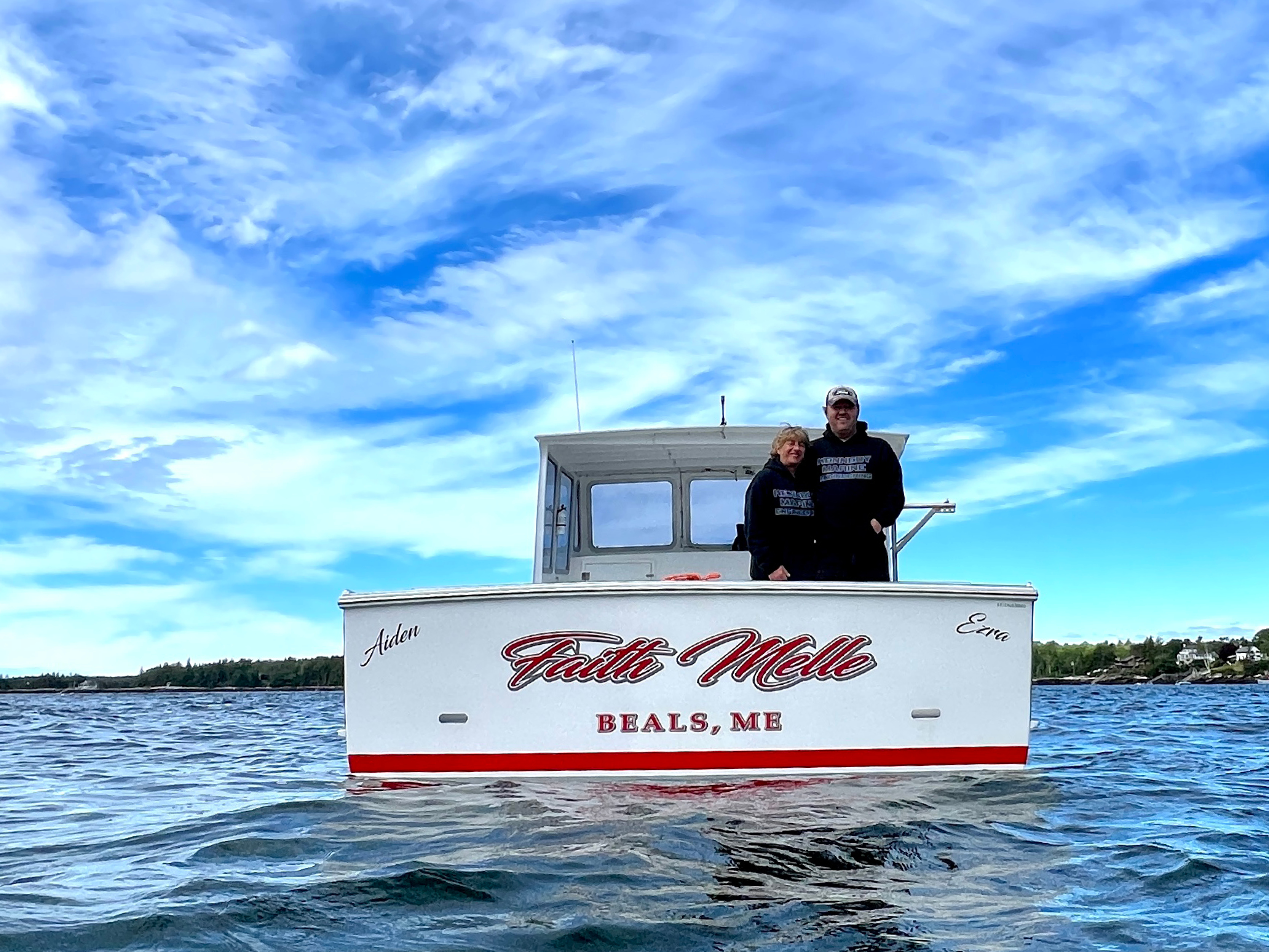Beals Island, Maine, lobsterman Winfred “Winnie” Alley has a new boat – a Libby 34 christened the Faith Melle.
“It’s my wife’s name, it’s pronounced Faith Mellay,” says Alley. “It’s an old family name.”
Theoretically, the Faith Melle is a commercial lobster boat that Winfred uses to set and haul lobster traps in the nearshore waters around Beals Island and along the adjacent coast. But fishing is not what he really built it for.
“I built it more for racing,” he says. “I bought the kit from Frank Coffin over at East Side. He had the cabin right there on the ground, so we put that on there and I screwed it into place.”
After stabilizing the hull with additional framing, Alley had the boat hauled some 40 miles down the coast to Addison, where he rented a boat shop to complete the project.
“It used to be Uncle Bunks Boatshop,” he says. Working about five or six hours a day, he completed the boat in three months.
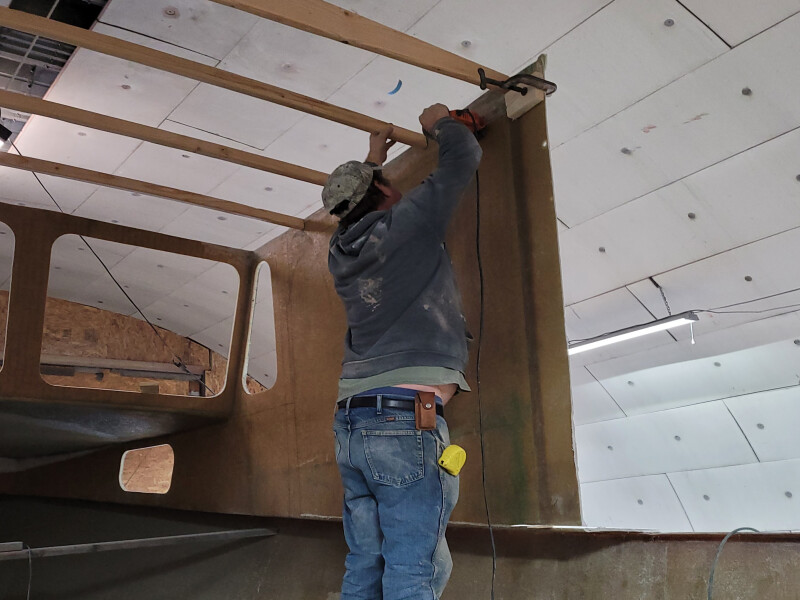
According to Frank Coffin, the owner of East Side Boats in Machiasport, Maine, he had originally built the boat for himself. “But I never could find time to finish it,” he says. “Winnie asked me for it, and we agreed to a fair price, and he took it. I love what he did with it, the colors. He does good work, very meticulous.”
Alley took the engine from his old fishing and racing boat, the Bounty Hunter, a Calvin Beal 34, and put it in the Faith Melle. “It’s a 425 Cummins,” he says. “It has low hours. I like it and I didn’t want to try and find another.”
Alley put a 1.75:1 Twin Disc gear on the Cummins, which turns a 2-inch diameter shaft that is only 10.5 feet long. Alley ran the shaft to a 24” x 26” 3-blade propeller. “If I was building just for fishing, I’d have probably used a four-blade, more power,” says Alley. “But I think I get more speed out of a three-blade. I don’t have anything to prove that, just my feeling that it goes faster.”
Alley and the Libby 34 go back quite a ways. “I’ve been lobster fishing since I was 17,” says the 51-year-old Alley. “I worked with Earnest Libby Jr. hauling in the summer and fall, and in the winter, I’d work in the boat shop with him.”
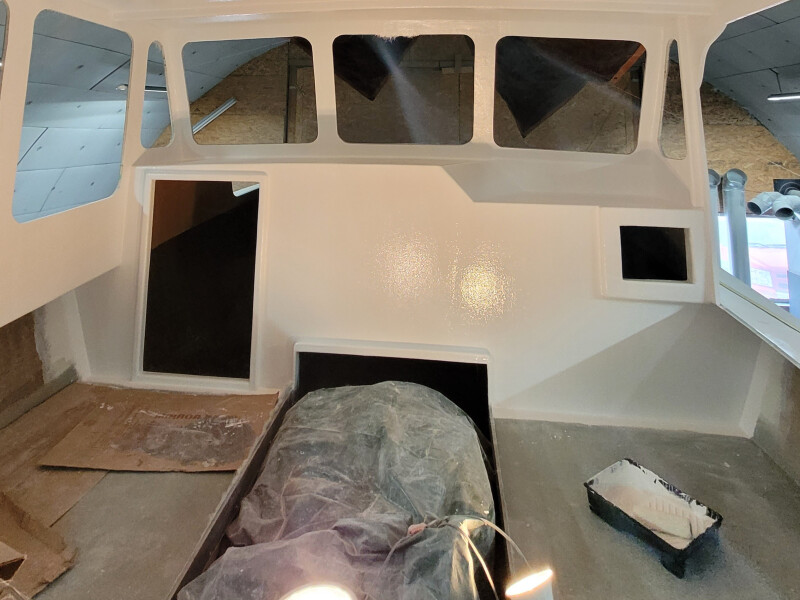
At Libby’s shop, Alley helped build the mold for the original 34. “We built the 38 first, then the 34. We built a wooden boat, fiberglassed it inside and out, smoothed it, and waxed the hell out of it,” he says. From that plug, they made the mold and started offering the 34-foot lobster boat for sale. “It’s 13-and-a-half-feet wide,” say Alley. “I’m not sure what she draws, it’s about 3-and-a-half feet.”
Frank Coffin primarily builds the Libby 41, and his own lengthened version, the Libby 47. He had bought the 38- and 34-foot molds from the widow of Stewart Workman, who had bought them from Earnest Libby. “I just didn’t want to lose them,” he says. “The 38 was destroyed, but we’ve made a new mold,” he says. “I had a 38 saved and we used that. I sold one to a fisherman in Alabama. Another guy he knew bought the plug and loved it so much he ordered a 41.”
For the 10 years before building the Faith Melle, Alley ran a plug boat for the Calvin Beal 34 mold. That was another wooden boat coated with fiberglass and smoothed with fairing compound and lots of sanding. “It’s a lot of maintenance,” Alley says. “It’s like a cored hull, but kind of like having a wooden boat. They use a lot of Polyfair to smooth it out, and in the winter when you haul it out, it starts cracking and the paint peels off. So, you’re always smoothing and sanding and painting.”
Nonetheless, the boat was fast and still is. “It’s what I race against,” says Alley. “My own boat.”
The Libby 34 was not perfect either, according to Coffin, mostly due to the condition of the mold. “They didn’t put a lot into building the molds back then,” he says. “And it’s never been reconditioned. It has a lot of dinks and bumps. But it’s the biggest of the 34s. It’s always been the widest, and it’s high-sided.” Coffin plans to recondition the 34 mold this year.
“Hopefully we’ll get to it in the fall,” he says, though he notes that things take more time these days. “I spend a lot of time on the road. I can’t get anything. If I need something, I might just as well drive to Rockland [150 miles], and walk in and get it.”
With his long familiarity with the Libby 34 hull, Alley knows how to get the most out of it. He likes to play with the shape, hoping to pick up a little speed. “Earnest used to talk about why he shaped the hull the way he did, bringing the bilges down in the stern so she has something to sit on and things like that, but I was young and didn’t pay attention,” says Alley. “Then when I got older and started building my own boats, I started to think about it more.”
When a hull comes out of the mold it’s just a shell, Alley explains. “You can change the shape a little. You can drop the bilges down, and put more rocker in her. What I did was jack the bottom down to give it more rocker, and put the shaft risers in.” He
then put in some temporary framing to hold everything in place and laid in the stringers and floor timbers. On the outside, he dropped the rails down, “to give her more lift,” he says.
In spite of the condition of the mold, Alley shaped and smoothed his new 34 into a fine-looking racing machine, and after some losses, the boat is winning. At the beginning of the race season, in the June races in Boothbay Harbor and Rockland, the Faith Melle didn’t perform as well up against his old boat, the Bounty Hunter.
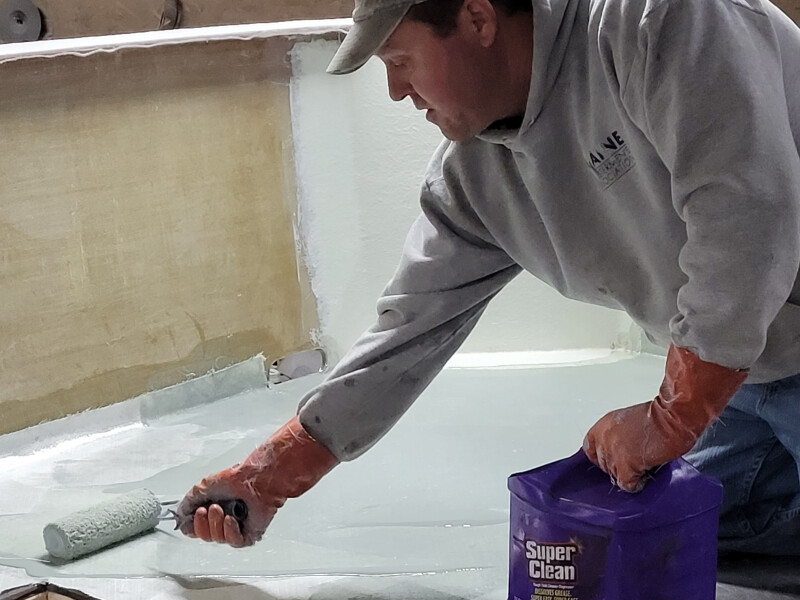
“I lost the first race,” he says. “And I lost the second one, but it was close. Then I figured out that the electronic throttle wasn’t opening all the way. I brought it over from the old boat, and I knew it had a problem. I knew it wasn’t opening all the way, but didn’t bother with it when I first put it in. We got that fixed and started winning.” The Faith Melle came out ahead in July races in Bass Harbor, Jonesport, and Stonington.
Faith Melle Alley points out that her husband’s expertise of building racing boats extends beyond his own boat. “I don’t know if anyone told you,” she says. “But Winnie worked on five boats that are finishing first and second in their divisions this year.”
According to Alley, the boats run a straight one-mile course, basically a drag race. “You have a boat going ahead with a person on the stern holding up a flag, and each boat has a flag on the stern. You go along at around 12 knots until they think everyone’s more or less lined up, and then they drop the flag on the lead board and off you go. It’s not perfect, and sometimes you wonder about the starts but…” Alley’s boat hits speeds in the high 30s. “With a fair tide and the wind with you, you might see 40 or a little more,” he says.
Alley built the boat light for racing, and it’s usually just him and his wife on the boat for race day. “I used composite for the cabin, the deck, and everything,” he says. “It’s called Coosa board. It’s very light. It’s all anyone’s using these days. I put that in and lay the fiberglass on it.”
Simplicity is what the Faith Melle is all about. “I don’t have any fish hold, just a lobster box on deck that holds about 400 pounds,” says Alley. There are no bunks down forward or amenities. When Alley and his wife head to more distant races like Stonington – a three-hour trip – or Boothbay Harbor – a six-hour trip – they stay ashore in a hotel.
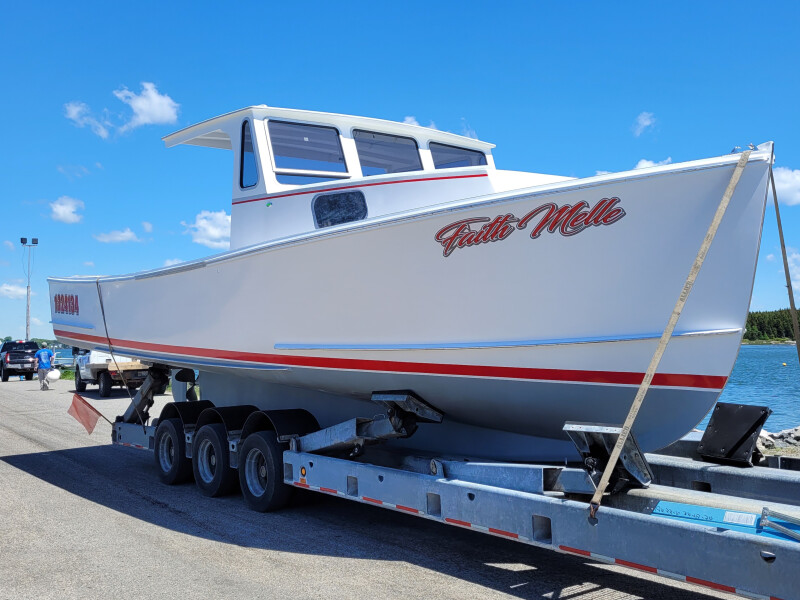
Alley’s fishing systems are simple: He has a 14-inch Hydro-Slave hauler, and his electronics are minimal. “I have a Standard Horizon VHF and a chart plotter,” he says. He has no sounder. “I’ve been fishing these same waters for the last 25 years,” he says. “I tried going offshore. I bought a 41. But that was the year the price dropped. I traded that boat for a smaller one and got out from under the payments. Now I just fish inshore.”
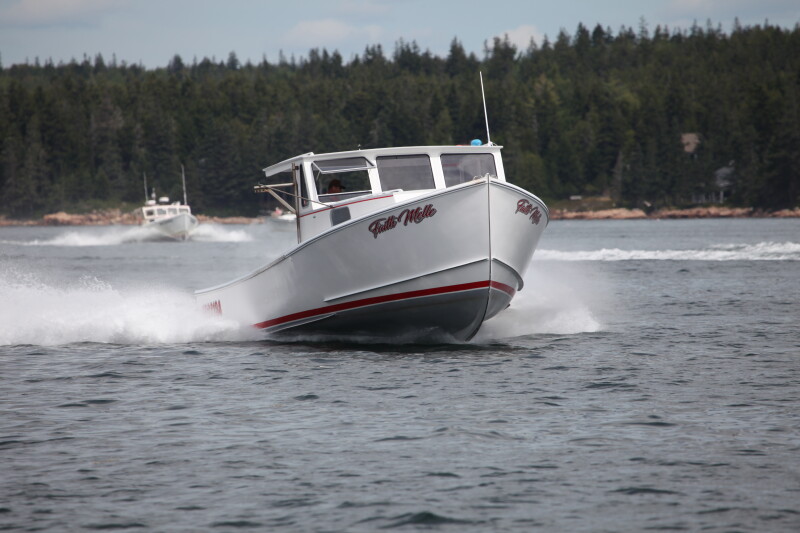
Being so familiar with the waters he fishes, he has no compass or radar. “I had a radar on the Bounty Hunter, but never turned it on. I just use the chart plotter. I suppose I could get in trouble if that ever went out.” He has no deck lights or spotlights, only his running lights. “I leave after sunrise and come home before dark. I don’t plan on being out fishing at night.” Not having a superstructure with lights and radar gives Alley a clean cabin top and cuts down on wind resistance, and that probably helps on the nose-to-nose wins.
At 51 years old, Winfred Alley is probably far from done building racing boats that also fish lobsters – and when the team at East Side Boats reconditions the old Libby 34 mold Alley helped build as a teenager, he may meet some new competition.





